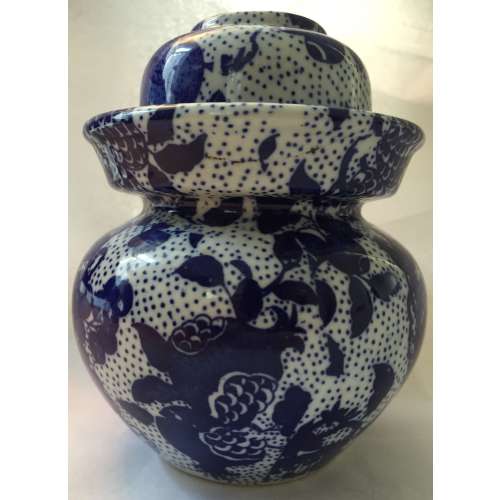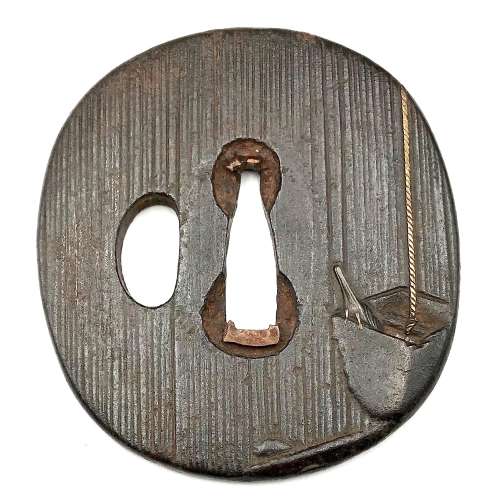-
 Bando Mitsugoro II as Soga no Taro Sukenobu, the step-father of the Soga brothers, and Osagawa Tsuneyo II as Onio's wife Tsukisayo, in the play 'Omonbi Kuruwa Soga' performed at the Ichimura-za in the 1st month of 1799. Reference: Harvard Art Museums accession number 1933.4.525. Publications: Narazaki Muneshige, Ukiyo-e shuka [Collection of the Masterpieces of Ukiyo-e Prints in Museums] Volume 8: Foggu Bijutsukan [Fogg Art Museum, Harvard University], Neruson Bijutsukan [Nelson Atkins Museum]..., Shogaku-kan (Tokyo, Japan, 1980 [Showa 55]), Color Plate 107; p. 104 (entry p. 191). SOLD
Bando Mitsugoro II as Soga no Taro Sukenobu, the step-father of the Soga brothers, and Osagawa Tsuneyo II as Onio's wife Tsukisayo, in the play 'Omonbi Kuruwa Soga' performed at the Ichimura-za in the 1st month of 1799. Reference: Harvard Art Museums accession number 1933.4.525. Publications: Narazaki Muneshige, Ukiyo-e shuka [Collection of the Masterpieces of Ukiyo-e Prints in Museums] Volume 8: Foggu Bijutsukan [Fogg Art Museum, Harvard University], Neruson Bijutsukan [Nelson Atkins Museum]..., Shogaku-kan (Tokyo, Japan, 1980 [Showa 55]), Color Plate 107; p. 104 (entry p. 191). SOLD -

Iron tsuba of circular form with the knotted geese (kari) flying over the rough waves pierced (sukashi) and carved in low relief (nikubori). Hitsu-ana plugged with soft metal. Hitsu-ana plugged with soft metal (tin or lead).
Signed: Echizen koku jū Myochin Katsuharu saku.
Edo period.Size: Height: 80.7 mm; Width: 81.0 mm; Thickness: 4.5 mm; Weight: 110 g.
Two tsuba of this master can be found at Georg Oeder Collection (Japanische Stichblätter und Schwertzieraten. Sammlung Georg Oeder Düsseldorf. Beschreibendes Verzeichnis von P. Vautier. Herausgegeben von Otto Kümmel.Oesterheld & Co / Verlag / Berlin, Oesterheld, 1915; LIB-1465 in this collection) under №№ 172 and 173, page 21, though no illustrations. SOLD. -
 Poem by Ariwara no Narihira Ason: (Actor Ichikawa Danjûrô VIII as) Seigen, from the series Comparisons for Thirty-six Selected Poems (Mitate sanjûrokkasen no uchi)「見立三十六歌撰之内 有原業平朝臣 清玄」 八代目市川団十郎. Poem: Yo no naka ni/ taete sakura no/ nakariseba/ haru no kokoro wa/ nodokekaramashi. Kabuki actor: Ichikawa Danjūrō VIII [八代目 市川 團十郎] (Japanese, 1823 – 1854); other names: Ichikawa Ebizô VI, Ichikawa Shinnosuke II. Artist: Utagawa Kunisada [歌川 国貞] a.k.a. Utagawa Toyokuni III [三代歌川豊国] (Japanese, 1786 – 1865). Block cutter: Yokokawa Horitake [横川彫武] a.k.a. Yokokawa Takejiro [横川竹二郎] (Japanese, fl. 1860s). Publisher: Iseya Kanekichi [伊勢屋兼吉] (Japanese, fl. 1840s – c. 1875) Year: 1852 (Kaei 5), 10th month. Size: Vertical ōban; 36.5 × 25.4 cm. Signed: Toyokuni ga, in toshidama cartouche [豊国画(年玉枠] Censors' seals: Fuku, (Muramatsu), Rat 10. Ref: MFA Accession № 11.36779.43.
Poem by Ariwara no Narihira Ason: (Actor Ichikawa Danjûrô VIII as) Seigen, from the series Comparisons for Thirty-six Selected Poems (Mitate sanjûrokkasen no uchi)「見立三十六歌撰之内 有原業平朝臣 清玄」 八代目市川団十郎. Poem: Yo no naka ni/ taete sakura no/ nakariseba/ haru no kokoro wa/ nodokekaramashi. Kabuki actor: Ichikawa Danjūrō VIII [八代目 市川 團十郎] (Japanese, 1823 – 1854); other names: Ichikawa Ebizô VI, Ichikawa Shinnosuke II. Artist: Utagawa Kunisada [歌川 国貞] a.k.a. Utagawa Toyokuni III [三代歌川豊国] (Japanese, 1786 – 1865). Block cutter: Yokokawa Horitake [横川彫武] a.k.a. Yokokawa Takejiro [横川竹二郎] (Japanese, fl. 1860s). Publisher: Iseya Kanekichi [伊勢屋兼吉] (Japanese, fl. 1840s – c. 1875) Year: 1852 (Kaei 5), 10th month. Size: Vertical ōban; 36.5 × 25.4 cm. Signed: Toyokuni ga, in toshidama cartouche [豊国画(年玉枠] Censors' seals: Fuku, (Muramatsu), Rat 10. Ref: MFA Accession № 11.36779.43. -
 SOLD A Chinese vessel with pomegranates and grapes, of two parts - the vessel and a cup. Blue and white porcelain, decorated under the glaze with a blue pigment by transfer-printing. Imperial reign mark on the bottom in zhuanshu script: Qianlong (1736-1795).
SOLD A Chinese vessel with pomegranates and grapes, of two parts - the vessel and a cup. Blue and white porcelain, decorated under the glaze with a blue pigment by transfer-printing. Imperial reign mark on the bottom in zhuanshu script: Qianlong (1736-1795). -

Iron tsuba of elongated round form with brown (chocolate) patina. The surface is carved with file strokes (sujikai-yasurime) to imitate heavy rain. The design of a bird drinking water from a bucket hanging on a rope is carved in low relief (sukidashi-bori); the rope is inlaid in gold. The well structure on the reverse, carved in low relief. Nakago-ana is enlarged and plugged with copper sekigane. Unsigned.
Edo period.Size: Height: 75.1 mm; Width: 68.3 mm; Thickness: 4.6 mm; Weight: 134 g.
Unsigned.
SOLD -
 Artist: Katsukawa Shunkō [勝川 春好] (Japanese, 1743 – 1812).
Artist: Katsukawa Shunkō [勝川 春好] (Japanese, 1743 – 1812).Actor: Matsumoto Kōshirō IV [[松本幸四郎]; other names: Omegawa Kyōjūrō, Ichikawa Komazō II, Ichikawa Somegorô I, Ichikawa Takejūrō, Segawa Kinji, Segawa Kingo] (Japanese, 1737 – 1802).
Signed: Shunkō ga. Size: Hosoban; 14 x 33 cm. SOLD -

Large oval form tsuba decorated with two human figures (scholar and attendant) under the pine tree admiring a view of a waterfall on the face of the plate, and with stylized dragons carved on the reverse among the symbols of thunder inlaid in gold. The plate is carved in low relief with details inlaid with gold and silver.
Signed: Yamashiro no kuni Fushimi no ju Kaneie [Kaneie of Fushimi in Yamashiro Province] [山城國伏見住金家], with Kaō. It is a fake signature (
gimei). Size: Height: 91.9 mm; Width: 85.6 mm; Thickness: 3.4 mm; Weight: 169 g.
This is a late Edo period, 19th-century export work to cater to the tastes of the European tsuba collectors. It does not have anything in common with the work of great Kaneie masters.
SOLD


